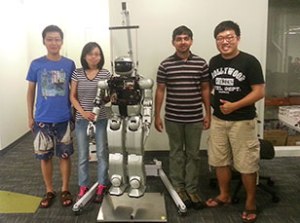Jul 18 2013
Researchers from Indiana University's School of Informatics and Computing are on a team that has advanced in the $2 million U.S. Department of Defense's DARPA Robotics Challenge to develop robots that can execute complex tasks in dangerous, degraded, human-engineered environments.
 At Drexel University this summer, from left, IU Ph.D. students Yajia Zhang and Jingru Luo are working on the DARPA Robotics Challenge with Purdue University students Manas Paldhe and Andy Park. Courtesy of Indiana University
At Drexel University this summer, from left, IU Ph.D. students Yajia Zhang and Jingru Luo are working on the DARPA Robotics Challenge with Purdue University students Manas Paldhe and Andy Park. Courtesy of Indiana University
The announcement marks the mid-point of the first phase of the 27-month challenge that began in October 2012. Phase 1 will culminate with trials in December and the teams that advance will receive additional funding from the Defense Department's Defense Advanced Research Projects Agency and move into Phase 2. At that point, teams will have 12 months to refine their designs before the final head-to-head competition in December 2014.
Members of IU's Intelligent Motion Lab, led by computer science assistant professor Kris Hauser, have been working with nine other universities on team DRC-Hubo to create their own robot platform and operation software for the humanoid robot Hubo. The IU contingent is working on giving Hubo the ability to climb ladders.
"We treat ladder climbing as a simultaneous software and hardware design problem," Hauser said. "Hardware design cycles are laborious and expensive, so we've been using extensive simulation testing over the past several months to optimize the design of Hubo. We developed motion planning algorithms that ensure that the new design can mount, climb and dismount a wide variety of ladders, ranging from vertical ladders to A-frame ladders to stair-like ladders."
Those recommendations were then given to team members at the Korea Advanced Institute of Science and Technology -- the developers of the first Hubo design -- who are now equipping the robot with stronger hands and longer, stronger arms. Two of Hauser's Ph.D. students, Yajia Zhang and Jingru Luo, are spending the summer at Drexel University putting the algorithms developed by IU into new hardware.
"Before running a new behavior on a robot, it should first be tested in simulation to avoid damaging the expensive hardware," Hauser added. "Existing robot simulators weren't able to accurately simulate the complex force distributions encountered during climbing, so we developed new simulation software. The results match quite well with the real world, and now other labs on the team are using our software to develop behaviors for their own tasks.
In addition to IU, Drexel and KAIST, the remaining members of the DRC-Hubo team are Columbia University, the University of Delaware, Georgia Institute of Technology, The Ohio State University, Purdue University, Swarthmore College and Worcester Polytechnic Institute.
The DRC-Hubo team has also for the first time physically concerted its efforts with representatives from each of the 10 team members on-site at Drexel's campus to collaborate throughout the summer. The team has constructed a full-scale mockup of a disaster site that will allow the robots to practice each of the eight events laid out by DARPA.
Each team member is charged with programming Hubo to perform one of eight disaster recovery-related tasks. IU and Purdue are tackling ladder-climbing; Drexel is programing the robot to get into and out of a vehicle; and Delaware researchers are developing a way for it to drive and navigate. Engineers from Ohio State are working on a way for it to climb over rough terrain; Georgia Tech's group is programming the robot to clear debris and break through a concrete wall; Swarthmore College roboticists are getting the robot to open a door; Worcester engineers are handling the task of turning a valve; and Columbia scientists are programming the robot to re-attach a hose.
The DARPA Robotics Challenge was inspired by the "Fukushima 50," the men who stayed behind at the Japanese plant to work to avert a nuclear meltdown following the earthquake and tsunami in 2011. IU received $130,000 in funding for the first phase, and that total will now rise to $251,152 for advancing to the second phase.
To speak with Hauser, or for more information, please contact Steve Chaplin, IU Communications, at 812-856-1896 or [email protected].